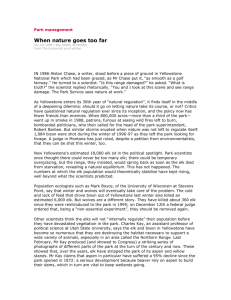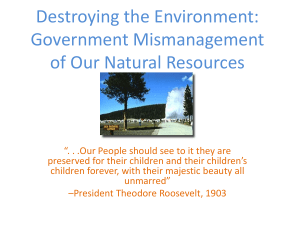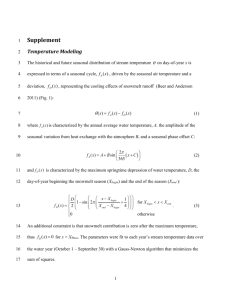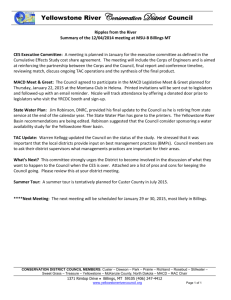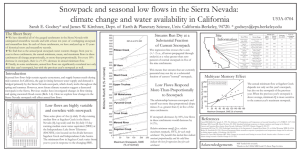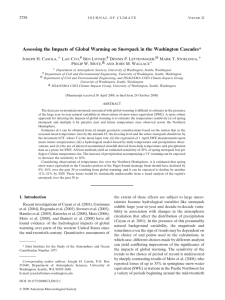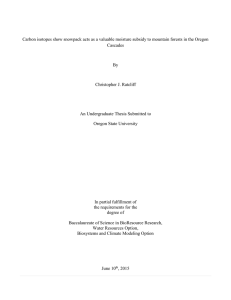Electronic Supplementary Material Validation of the "Langur
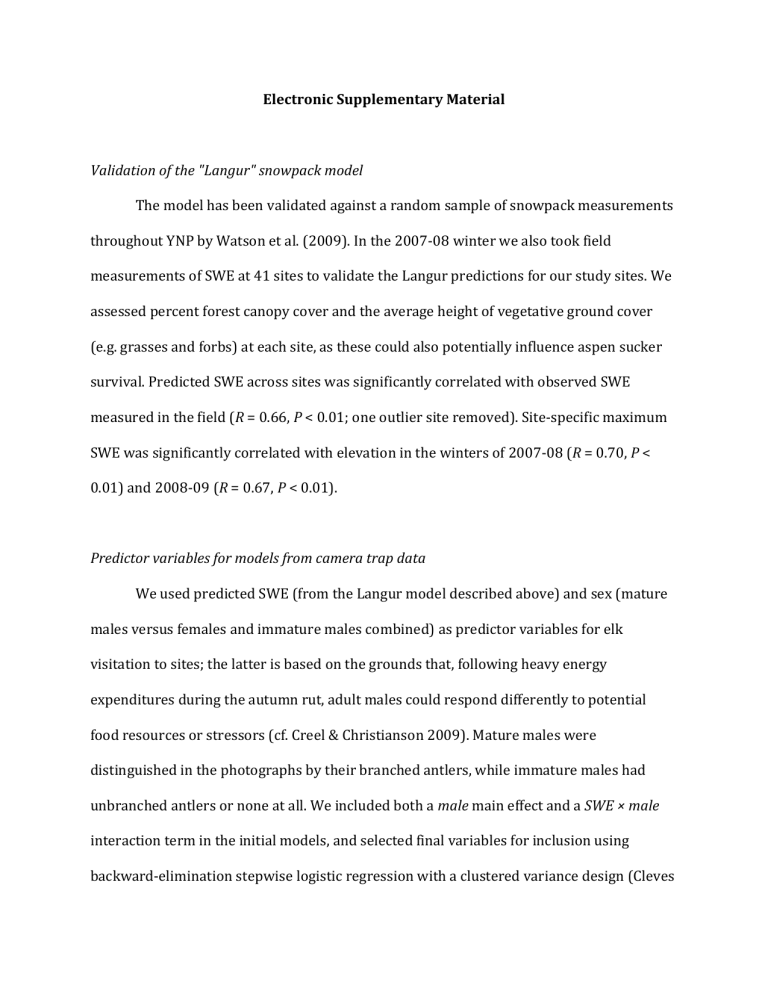
Electronic Supplementary Material
Validation of the "Langur" snowpack model
The model has been validated against a random sample of snowpack measurements
throughout YNP by Watson et al. (2009). In the 2007-08 winter we also took field
measurements of SWE at 41 sites to validate the Langur predictions for our study sites. We assessed percent forest canopy cover and the average height of vegetative ground cover
(e.g. grasses and forbs) at each site, as these could also potentially influence aspen sucker survival. Predicted SWE across sites was significantly correlated with observed SWE measured in the field (R = 0.66, P < 0.01; one outlier site removed). Site-specific maximum
SWE was significantly correlated with elevation in the winters of 2007-08 (R = 0.70, P <
0.01) and 2008-09 (R = 0.67, P < 0.01).
Predictor variables for models from camera trap data
We used predicted SWE (from the Langur model described above) and sex (mature males versus females and immature males combined) as predictor variables for elk visitation to sites; the latter is based on the grounds that, following heavy energy expenditures during the autumn rut, adult males could respond differently to potential
food resources or stressors (cf. Creel & Christianson 2009). Mature males were
distinguished in the photographs by their branched antlers, while immature males had unbranched antlers or none at all. We included both a male main effect and a SWE × male interaction term in the initial models, and selected final variables for inclusion using
backward-elimination stepwise logistic regression with a clustered variance design (Cleves
et al. 2010). The final daily visitation model from backward-elimination stepwise multiple
logistic regression was (also see Figure S1):
Snowpack decline in the Yellowstone Ecosystem
Significant declines in northern Yellowstone winter snowpack have been observed
directly for 1948-2003 (Wilmers & Getz 2005); we complemented this with an analysis of
an index of winter snowpack over the entire twentieth century. We examined long-term snowpack dynamics in the Yellowstone Ecosystem using a time series of the Palmer
Drought Severity Index (PDSI) averaged from November-May. PDSI data came from the
National Climatic Data Center of the National Oceanic and Atmospheric Administration for
Division 1 ("Yellowstone Drainage") of Wyoming, accessed at http://www7.ncdc.noaa.gov/CDO/CDODivisionalSelect.jsp#.
To assess historical change in snowpack conditions in the Yellowstone Ecosystem, we analyzed trends in an index of snowpack, the November-May average Palmer Drought
Severity Index (PDSI) for the Yellowstone Drainage in Wyoming. Winter PDSI in this region declined (indicating drier conditions) significantly from 1895-2008 (slope = -0.06, R 2 =
0.31, P < 0.01; Figure S2).
Additional discussion of altered snowpack as a mechanism of climate change
Changing snowpack conditions could alter species interactions across mid- and high-latitude systems. Snow is a strong abiotic driver of ecological conditions in these
regions (Jones et al. 2001), and changes in winter conditions may be a critical facet of
climate change (Kreyling 2010). For example, muskoxen (Ovibos moschatus) spatial
distribution and social organization in Greenland respond to changes in plant productivity
driven by variation in snow (Forchhammer et al. 2005). Moreover, the expansion of elk
winter distribution in Arizona in response to two-decade declines in snowpack may be responsible for strong increases in browsing levels and local reduction in deciduous tree
Supplementary literature cited
Cleves, M., Gutierrez, R. G., Gould, W. & Marchenko, Y. V. 2010 An introduction to survival
analysis using Stata. College Station, Texas: Stata Press.
Creel, S. & Christianson, D. 2009 Wolf presence and increased willow consumption by
Yellowstone elk: implications for trophic cascades. Ecology 90, 2454-2466.
Forchhammer, M. C., Post, E., Berg, T. B. G., Hoye, T. T. & Schmidt, N. M. 2005 Local-scale and short-term herbivore-plant spatial dynamics reflect influences of large-scale climate. Ecology 86, 2644-2651.
Jones, H. G., Pomeroy, J. W., Walker, D. A. & Hoham, R. W. (ed.) 2001 Snow ecology: an
interdisciplinary examination of snow-covered ecosystems. Cambridge, UK:
Cambridge University Press.
Kauffman, M. J., Varley, N., Smith, D. W., Stahler, D. R., MacNulty, D. R. & Boyce, M. S. 2007
Landscape heterogeneity shapes predation in a newly restored predator-prey system. Ecology Letters 10, 690-700.
Kreyling, J. 2010 Winter climate change: a critical factor for temperate vegetation performance. Ecology 91, 1939-1948.
Martin, T. E. 2007 Climate correlates of 20 years of trophic changes in a high-elevation riparian system. Ecology 88, 367-380.
Watson, F. G. R., Anderson, T. N., Newman, W. B., Cornish, S. S. & Thien, T. 2009 Modeling spatial snowpack dynamics. In The ecology of large mammals in central Yellowstone
(ed. R. A. Garrott, P. J. White & F. G. R. Watson), pp. 85-112. Amsterdam: Academic
Press.
Wilmers, C. C. & Getz, W. M. 2005 Gray wolves as climate change buffers in Yellowstone.
PLoS Biology 3, e92.
Table S1: Model selection for the influence of snow water equivalent (SWE), elevation
("Elev"; m), forest cover ("Forest"; %), height of the ground vegetation ("Ground"; cm), and
predation risk (from Kauffman et al. 2007) on annual aspen sucker survival. All models also
included sucker height (cm; see Table 1 in main text) as a predictor variable.
Model
SWE
Elev
AIC
1032.68
1046.82
∆AIC
0.00
14.14
Akaike weight
0.996
0.001
Forest
Ground
Predation risk
Elev + Forest
Elev + Ground
1051.26
1051.41
1051.28
1046.12
1047.03
18.59
18.74
18.61
13.44
14.36
0.000
0.000
0.000
0.001
0.001
Forest + Ground
Elev + Forest + Ground
1053.26
1046.38
20.58
13.71
0.000
0.001
Table S2 : Model selection for the influence of snow water equivalent (SWE) versus
predation risk (from Kauffman et al. 2007) on aspen browsing rate (winter height change).
Both models also included sucker height (cm; see Table 1 in main text) as a predictor variable.
Model AIC ∆AIC Akaike weight
SWE
Predation risk
1595.52
1597.91
0.00
2.39
0.768
0.232
Figure S1: Visitation to aspen stands by female and immature male elk (A) and mature male elk (B) versus weekly-averaged snow water equivalent (SWE). Predicted probability of daily visitation to aspen stands by female and immature male elk (C) and mature male elk
(D) versus predicted daily SWE, with 95% confidence limits.
Figure S2: Annual (dashed lines and open circles) and 5-year running average (solid line)
Nov-May Palmer Drought Severity Index (PDSI) for the Yellowstone River Drainage in
Wyoming.


